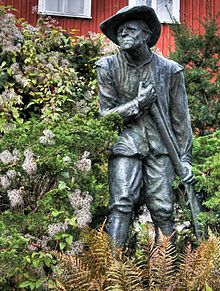Snapphane
A gloomy consequence of this kind of warfare was that the land around the fortresses was completely destroyed because of scorched earth tactics where both sides burned everything, so that the enemy did not get it.When Scanian exiled peasants were organized by the Danish king into bands that fought the Swedes with guerrilla warfare, they were also referred to as snapphane.Because the movement supported the Danish invasion during the Scanian War, Swedish authorities fought the snapphanar brutally, and if captured, these fighters were usually executed and their corpses impaled and shown where the locals could see them and be intimidated into obedience.The snapphane movement was eventually defeated by a ruthless campaign waged by the Swedish Army, compelling all Scanian peasants to swear allegiance to the King of Sweden.A determined Swedification policy was reportedly so effective that when a Danish invasion army landed in 1709 in the wake of the Battle of Poltava, the local population was raised in a militia to fight against them.
Snapphanar (TV-series)LönsbodaSvend PoulsenIdeologyDanishSwedenguerrillaauxiliariesparamilitarytroopsSwedesSecond NorthernScanian Warssouthern SwedenSwedishillegal combatantsspecial forcesDanish armysupply linesintelligenceSwedish taxtraitorsRingsjöncavalryDanish militaryDenmarkhundredCopenhagenScanianGermansyeomanSwedish forcesguerrillasbailiffsforagingbanditslooterscarpetbaggersSwedish armyScaniano-man's landScanian warenclavesLandskronaHelsingborgMalmöKristianstadstatelesspetty warEuropewar of attritiongarrisonsSkåneKristiansandNorwayHabsburgpejorativepeasantsguerrilla warfareimpaledbreaking wheelKing of SwedenBattle of PoltavaHässleholmSwedish Navypatrol boatprivateerNatur & KulturSnapphanarEdvard PerssonSnaphance